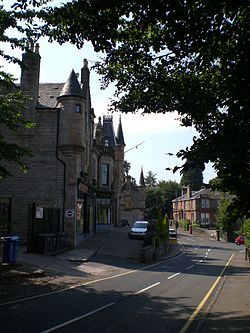Bridge of Weir
| Bridge of Weir Scots: Brig o' Weir | |
| Renfrewshire | |
|---|---|
 Bridge of Weir | |
| Location | |
| Grid reference: | NS387655 |
| Location: | 55°51’23"N, 4°34’40"W |
| Data | |
| Population: | 4,635 (2001) |
| Post town: | Bridge of Weir |
| Postcode: | PA11 |
| Dialling code: | 01505 |
| Local Government | |
| Council: | Renfrewshire |
| Parliamentary constituency: |
Paisley and Renfrewshire North |
Bridge of Weir is a village in Renfrewshire, sitting within the Gryffe Valley, at a crossing point for the River Gryffe. The village today serves largely as a dormitory settlement for nearby Glasgow and Paisley although it maintains a commercial centre of its own and some light industry.
History
Bridge of Weir was historically an area divided between the parishes of neighbouring Houston and Kilbarchan on either side of the River Gryffe.[1] Growing out of the lands of Ranfurly, mainly occupied by small farms, the name 'Bridge of Weir' is first recorded in the early 18th century before any village was built. The 'weir' is a reference to a salmon weir which used to be located on the Gryffe. An older name provided for the village is 'Port o'Weir', implying a river crossing; this name remained in some use even after the Bridge of Weir name had been adopted.[2]
The bridge at Bridge of Weir was constructed at Burngill c.1770 and was considerably upgraded and widened in 1892 to allow for two-way traffic. It was finally demolished in 1964, with a more modern structure created. The bridge owes its construction to being on the route between the significant towns of Greenock and Paisley, with a Great Road constructed between the two in 1794. Also significant to the infrastructure of the emerging settlement was the construction of the Glasgow, Paisley and Ardrossan Canal which, despite its ambitious name, was only constructed up to nearby Johnstone. The Johnstone to Bridge of Weir railway route was formalised on the 20 June 1864 and the Bridge of Weir railway station built. The line extended to Kilmacolm and onwards in 1869. This railway substantially altered the character of the village and contributed to its forthcoming affluence. The railway closed on 10 January 1983 and now forms part of the Clyde to Forth cycle route (National Cycle Route 75).
The first semblances of the village came to be with the rise of the cotton industry. From around 1793 the river Gryffe was being used to power numerous cotton spinning and blanket making mills. The most significant industry to emerge in the village was leather.
Leather
At its peak of productivity, this small village supported three tanneries. The leather industry survives to this day, now on a single site, in the form of a highly successful, modern facility with four Queen's Awards for International Business.
In 1989, the benches of the House of Commons and House of Lords chambers in the Palace of Westminster were reupholstered using Bridge of Weir leather.[3]
Bridge of Weir Leather has supplied amongst others:
- Upholstery for famous ocean liners including the Lusitania, Queen Mary, Queen Elizabeth and QE2 and the Royal yacht Britannia, the Aurora Princess and Sunseeker yachts.
- The Houses of Parliament, The Old Bailey and many notable public buildings around the world.
- Airlines
- Car makers including Aston Martin, McLaren Cars, Lincoln cars, Mercedes AMG, Saab, Volvo, Jaguar, Land Rover, and the original (UK-built) Model T Fords.
Recreation
Bisected by the River Gryffe, angling is available within the village. The river hosts brown trout, grayling and occasionally Atlantic salmon. Numerous outdoor pursuits are available at the nearby Clyde Muirshiel Regional Park.
National Cycle Route 75 runs through the village.
The village is also known for its golf history. At one point there were five golf courses in the vicinity; today there are two remaining: the Old Course Ranfurly and the Ranfurly Castle golf clubs.
There was a thriving ice hockey team from around 1895.

Outside links
| ("Wikimedia Commons" has material about Bridge of Weir) |
- Bridge of Weir Community Council
- Bridge of Weir Post Office, Shop & Community Centre
- Brighter Bridge of Weir voluntary group
- Bridge of Weir Festival
References
- ↑ Information on Bridge of Weir from GENUKI
- ↑ W. Lyle, Bridge of Weir, ISBN 0-9503943-0-0, p.6-7
- ↑ Renfrewshire Community Website - Bridge of Weir